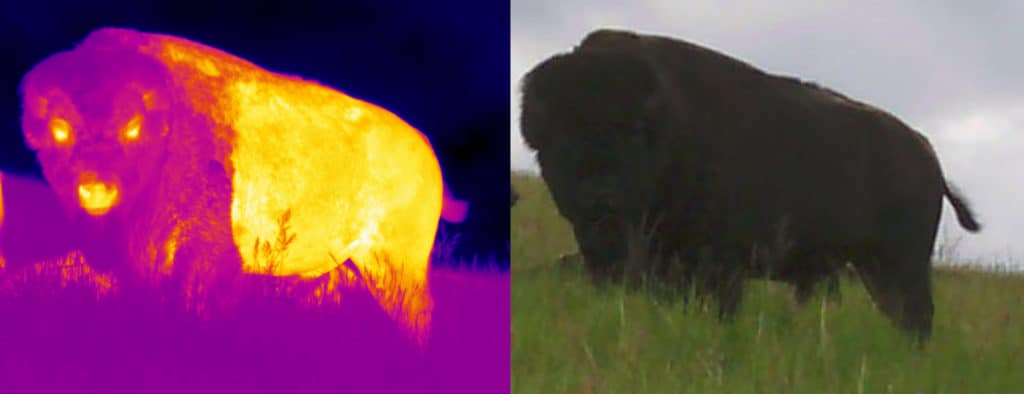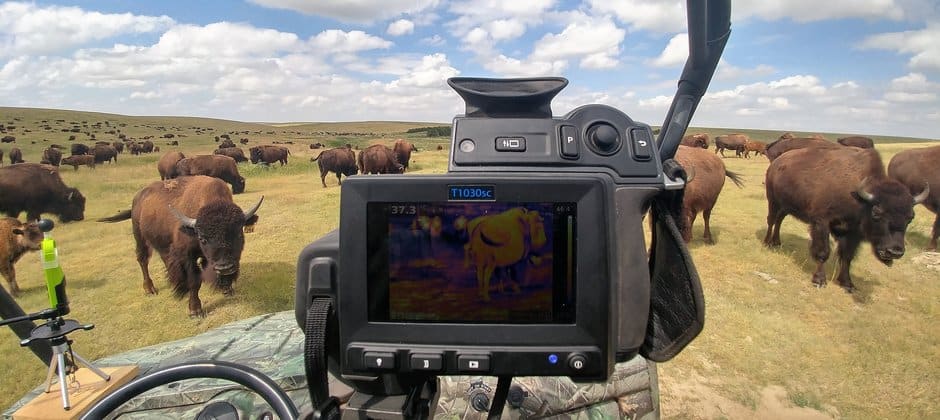Share this article
Thermal imaging reveals shrinking bison mechanisms
As bison take in more and more heat as a result of climate change, their bodies are becoming smaller and smaller, since they’re putting their energy toward keeping cool rather than bulking up.
Jeff Martin, a Boone and Crocket doctoral research fellow at Texas A&M University, previously looked at bison (Bison bison) fossils from over 40,000 years ago and over the last five decades and found that bison have shrunk over the years as drought has increased and temperatures have risen. But he wanted to find out how they were taking on heat and if that was the cause for their decrease in size.
In the study published in Ecosphere, Martin and his colleagues used thermal imagery to determine the amount of heat bison were taking in and where they were taking in heat. The thermal imagery used white and yellow for hot areas and blues and purples for cooler areas. For bison, most of their heat is focused around the abdomen.
The team converted temperature from the thermal imagery into watts of energy. “By converting it into watts of energy, we have a common currency to find out or quantify how much energy they’re transferring,” he said. “Temperature is great, but doesn’t account for how energy is being produced.”
Then, they accounted for body size of adolescent bison. Martin took a trip 9,000 miles from Texas to Saskatchewan and back in the summer of 2017, and he did it again in the winter of 2018, checking in on bison at 19 locations along the way. In each spot, he estimated the bisons’ height using a digital laser rangefinder and took pictures with a thermal imaging camera. Using the data, they were able to see what the biggest drivers were of heat transfer in bison, which varies season to season.

Bison expel more heat in their abdomen areas, which shows up as white and yellow in thermal imagery. Credit: Jeff M. Martin
They found that bison growth decreased with increasing heat transfer. Heat transfer also increased in bison from north to south. “The whole kicker of what this all means is, the more heat transfer you have to work with and expend to stay cool, the less you have available for growth,” he said.
Martin said he wouldn’t have been able to find this out without thermal imaging. “We can get huge data samples within a year instead of having to do extra chemistry directly measuring energy budgets,” he said.
As temperatures continue to increase — summer temperatures in the Great Plains are likely to rise 5 degrees Celsius by the end of the century — Martin expects bison will continue to get smaller. Winter temperatures will also warm pretty quickly, he said.
“Winter is supposed to be a time of rest for them,” Martin said. “They’re going to have to burn more energy when they’re usually resting and relatively cool.” A decrease in body size can also impact reproduction and litter size, he said.
Martin suggests managers explore prescribed fire to boost nitrogen and carbon in plants to give bison more energy, planting trees to give the bison shade and creating water features for them.
“It’s going to have to require people to try different ways and experiment,” he said. “It’s not going to work the same everywhere.”
Header Image: Researchers used thermal energy to determine how much heat bison were transferring. Credit: Jeff M. Martin








